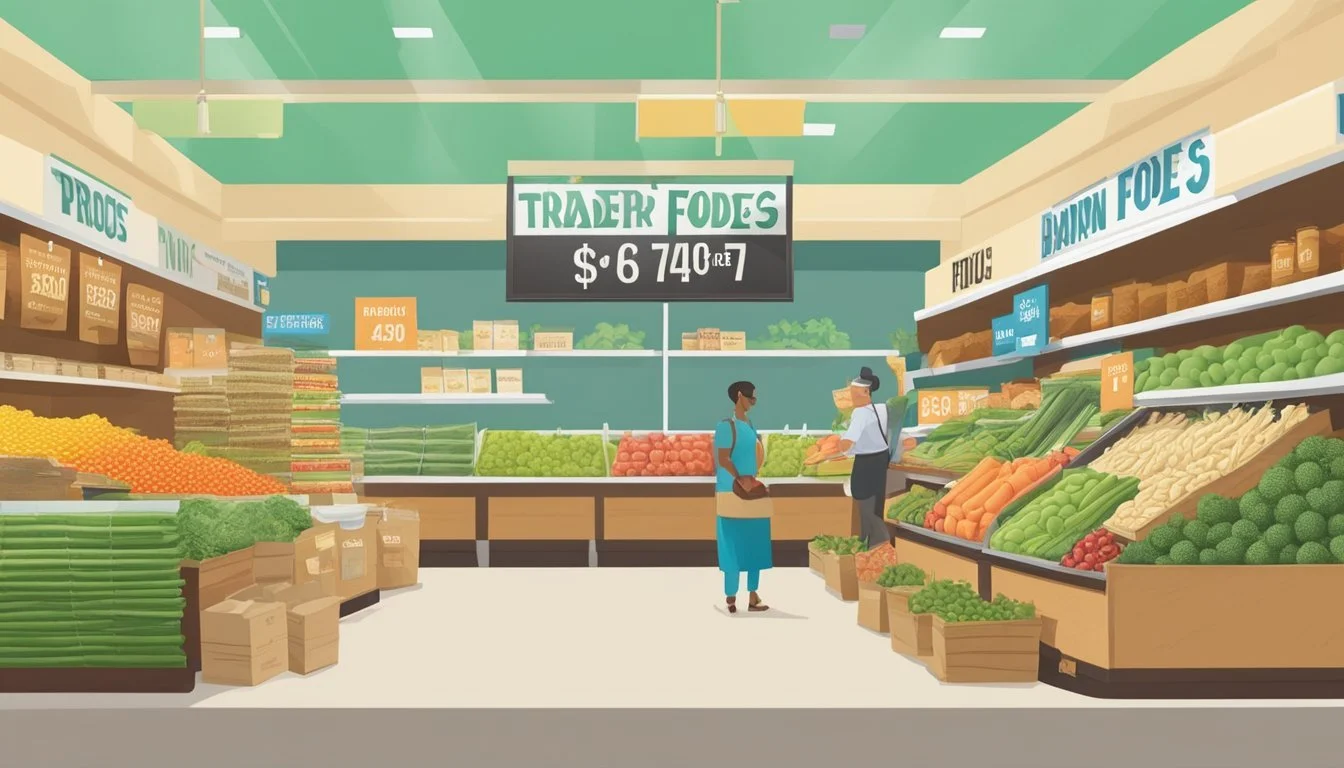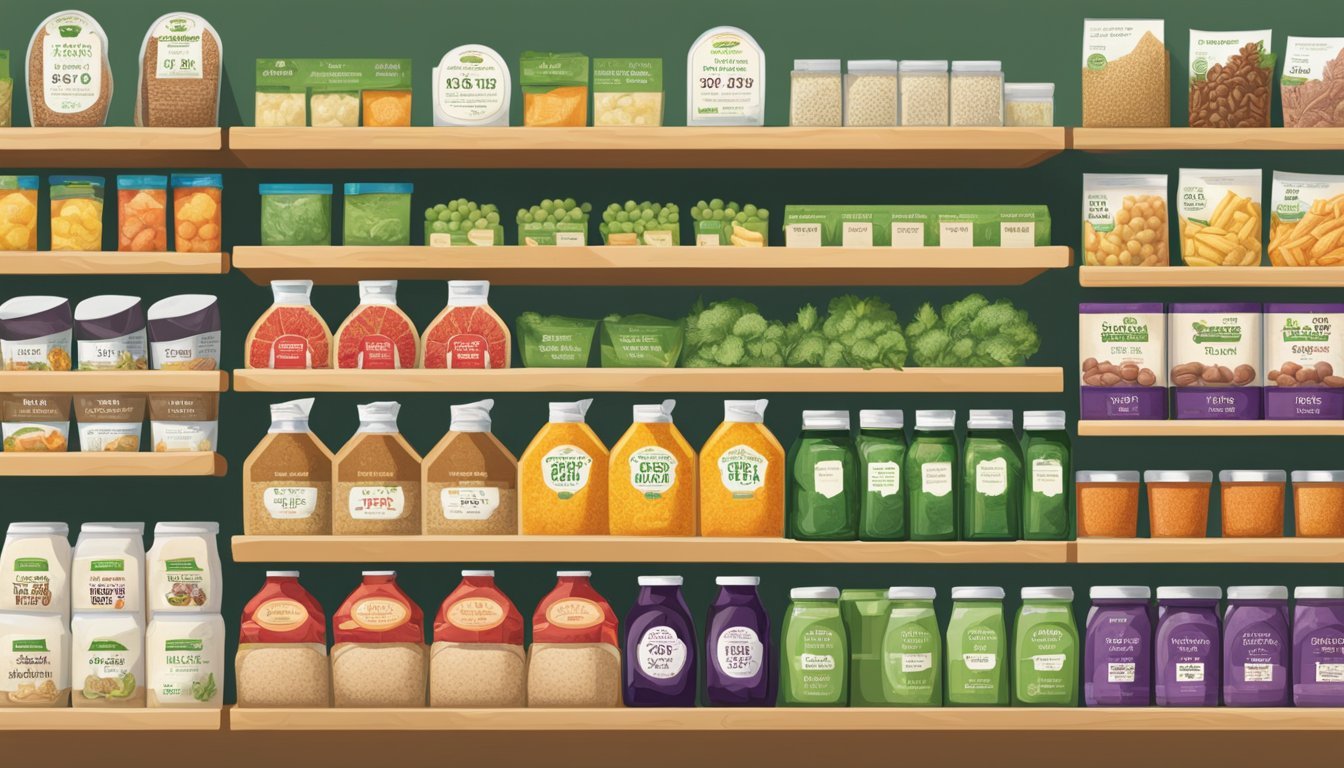Is Whole Foods Cheaper Than Trader Joe's?
Examining Grocery Pricing Differences
Part of Our Grocery Store Guide with Details on Whole Foods Market Prices and Trader Joe's Prices
Consumers seeking quality groceries often find themselves comparing prices between the leading grocery chains, Whole Foods and Trader Joe's. The debate centers on which retailer offers the best value for their money. Whole Foods, often referred to as "Whole Paycheck," has a reputation for higher prices but also for a wide variety of organic and specialty products. On the other hand, Trader Joe's is known for its curated selection of products at competitive prices, appealing to budget-conscious shoppers with its private-label goods.
The price comparison between Whole Foods and Trader Joe's is not just about the numbers on the price tag; it extends to the shopping experience and variety. While Trader Joe's may offer lower cost basics, Whole Foods presents a broader selection, including premium, organic, and locally sourced items that can justify the extra expense for some shoppers. The two stores target different niches in the grocery market, which reflects in their pricing and product selection strategies.
Determining which store is cheaper requires consideration of shopping habits, product preferences, and value placed on organic and specialty items. Shoppers prioritizing cost savings, particularly on conventional products, may lean towards Trader Joe's. In contrast, those who put a premium on a wider selection, including higher-end health-conscious options, might find Whole Foods to be more aligned with their shopping needs despite the potentially higher costs associated with their purchase.
Overview of Whole Foods and Trader Joe's
Whole Foods and Trader Joe's are two prominent grocery chains in the United States, each with a unique approach to the retail food experience. They have developed distinctive brand philosophies and a strong market presence, which resonate with their respective customer bases.
Brand Philosophy
Whole Foods adheres to a philosophy of offering natural and organic products, positioning itself as a leader in health-conscious retail. Acquired by Amazon in 2017, Whole Foods often carries a reputation for higher prices, which has led to the nickname "Whole Paycheck." Despite this, it maintains a strong commitment to quality, with stringent standards for product selection and a focus on sustainability.
Trader Joe's, part of the Aldi Nord family (separate from Aldi US, which is part of Aldi Süd), encapsulates a smaller, neighborhood grocery store model. It is known for its curated selection of private-label brands that offer consumers a blend of value and uniqueness. Unlike Whole Foods, Trader Joe's keeps its product offerings limited to around 4,000 SKUs, in sharp contrast to traditional retailers like Walmart or Kroger that stock upwards of 50,000 SKUs.
Market Presence
Whole Foods has a broad market presence with hundreds of stores scattered across North America and the UK. With Amazon's acquisition, it has expanded its digital footprint, integrating with Amazon's e-commerce platform and offering benefits to Amazon Prime members.
Trader Joe's operates a significant number of stores in the United States and continues to expand. Known for its loyal customer base, it competes effectively with other grocery chains by emphasizing friendly customer service, a quirky shopping environment, and competitive pricing that often undercuts larger competitors like Walmart and Kroger, especially in the non-organic produce and private-label categories.
Price Comparison Fundamentals
When it comes to deciding whether Whole Foods or Trader Joe's offers the better deal, consumers must consider the intricacies of each store's pricing strategy, the shopping experience, and public perception. These factors collectively influence the perceived and actual price savings on groceries.
Understanding Pricing Strategy
Whole Foods is known for its wide range of organic and specialty items, often priced higher owing to quality claims and sustainable sourcing. On the other hand, Trader Joe's typically undercuts competitors with its private label products that reduce marketing and distribution costs. Price comparison here is sensitive; staple items might skew cheaper at Trader Joe's, but one may find certain organic options more budget-friendly at Whole Foods.
Comparative Shopping Experience
Both stores curate a unique shopping experience that affects consumer's comparative habits. Trader Joe's offers a more limited selection, streamlining the decision process, which may result in a lower overall bill due to fewer impulse buys. Whole Foods markets a larger variety, including an abundant selection of specialty items which might prompt shoppers to spend more than they intended.
Consumer Perception On Prices
Perceptions around prices play a pivotal role. Consumers often perceive Whole Foods as a higher-priced grocer—some have nicknamed it "Whole Paycheck"—whereas Trader Joe's is viewed as more budget-friendly. Actual price comparisons have solidified this view. Surveys point out that, on average, Trader Joe's is more economical, especially when shopping for cheaper staples. However, cost discrepancies vary and can be less significant for certain items.
Product Comparison by Category
In comparing Whole Foods and Trader Joe's, the categories of produce, dairy and meat, packaged foods, organic selection, and non-food items have distinct differences in terms of cost and variety that consumers should consider.
Produce Quality & Variety
Whole Foods is known for a wide variety of produce, including both organic and non-organic options. Customers have reported that the quality, especially of organic produce such as strawberries and blueberries, tends to be higher at Whole Foods. In contrast, Trader Joe's offers a more curated selection of produce which usually comes at a lower price point, yet still maintains quality with popular items like spring mix and apples.
Meat and Dairy Products
The meat selection at Whole Foods often includes a larger assortment of organic and responsibly raised options, which can be more expensive than those available at Trader Joe's. For dairy products, both stores offer a range of options including cheese and milk; however, Trader Joe's may have an edge on price for similar quality items.
Packaged Foods and Brand Offerings
Trader Joe's is celebrated for its wide array of packaged foods, like their cult-favorite frozen pizzas and prepared foods, typically priced below those at Whole Foods. On the other hand, Whole Foods provides an extensive range of branded and specialty foods, which includes items like high-quality olive oil and exclusive brands that might be appealing to those seeking unique options.
Organic Selection
Whole Foods has an extensive selection of organic foods across various departments, which justifies the higher price for consumers dedicated to organic items. Trader Joe's also offers a range of organic selections, but their variety might be narrower when compared to Whole Foods, particularly in specific products like organic meat or specialized organic dairy offerings.
Non-Food Items
For non-food items such as personal care and household products, Trader Joe's generally provides more cost-effective options. Both retailers stock organic and eco-friendly products, with Whole Foods typically offering a broader diversity but at a higher price point.
Factors Influencing Cost
When considering the cost difference between Whole Foods and Trader Joe's, it is essential to examine the specifics of their supply chain operations and the role of private versus national brand products that each retailer offers.
Supply Chain Dynamics
Whole Foods and Trader Joe's have distinct supply chain strategies that directly affect their product pricing. Whole Foods, which is now a part of the Amazon family, focuses on offering a wide range of organic and non-GMO products, often at a premium due to higher sourcing and certification costs. Trader Joe’s, on the other hand, keeps costs low through a centralized distribution system, which reduces handling and shipping expenses.
Private Label Brands vs. National Brands
Both retailers prominently feature their own private label brands, which have a substantial impact on overall pricing. Whole Foods markets its 365 brand, a line that promises lower prices compared to name-brand products while maintaining quality. Conversely, virtually all products at Trader Joe's are under the Trader Joe’s brand, which cuts out middlemen and enables them to offer goods at a lower price point. Notably, Trader Joe's is owned by the same German company as Aldi Nord, which is famed for its cost efficiency and savings passed on to the consumer.
Healthy Eating and Organic Foods
When considering Whole Foods and Trader Joe's, one must take into account their offerings in organic and natural foods, as well as the implications for cost and health.
Availability of Organic and Natural Foods
Whole Foods has long been synonymous with organic and natural food options. They offer an expansive assortment, including organic avocados, organic milk, and a variety of non-dairy milk options like soy milk. Following its acquisition by Amazon, Whole Foods has continued to prioritize access to high-quality organic products.
Trader Joe's also provides a selection of organic and natural products, albeit within a smaller store footprint. They focus on house brands and offer a curated selection that includes organics, often at competitive prices. Both grocers understand the demand for natural foods and strive to supply them, yet Whole Foods maintains a larger variety as part of its core brand identity.
Impact on Cost and Health
Item Trader Joe's Price Whole Foods Price Organic Avocados $1.00 $1.50 Organic Milk (1gal) $5.49 $5.99 Soy Milk (1qt) $2.29 $2.49
The cost of organic food can be higher than non-organic due to more stringent farming practices. For health-conscious consumers, the premium is often justifiable by the perceived health benefits and environmental considerations. Trader Joe's has been noted for its lower prices on certain organic staples, as shown above, which may make it a preferable option for budget-minded shoppers who do not want to compromise on the quality of their food. Meanwhile, Whole Foods' pricing reflects its commitment to a larger range of organic products and partnerships with organic farmers. Both grocers offer options that support healthy eating lifestyles, but the scales of variety and cost tip differently depending on the consumer's priorities.
Analysis of Staple Products Prices
In comparing Whole Foods and Trader Joe's, staple products often serve as common ground to assess value and affordability.
Grains and Cereal
Oats: Trader Joe's offers a competitive price on oats, often coming in at a lower price point compared to Whole Foods, where a same-size organic option could be slightly higher.
Quinoa: Whole Foods typically features a broader variety of quinoa, including specialty options that may lead to higher prices, while Trader Joe's maintains affordability with fewer options.
Brown Rice
Trader Joe's: $2.99 for 32 oz of Organic Brown Rice
Whole Foods: $3.49 for 32 oz of Organic Brown Rice
Oils and Fats
Almond Butter: Trader Joe's almond butter tends to be more budget-friendly than Whole Foods, which may offer a wider range, including premium and locally sourced varieties.
Coconut Oil: For coconut oil, both stores sell similar qualities, but Trader Joe's typically undercuts Whole Foods' price, making it the more economical choice.
Snacks and Sweets
Honey: At Whole Foods, shoppers find multiple choices, including raw and local honey, which might be pricier. Trader Joe's keeps its selection simple and cost-effective.
Granola: When comparing granola, Trader Joe's generally has lower prices for standard flavors, while Whole Foods can charge more for artisanal or organic variants.
Cost Comparison of Fresh Produce
In examining the cost comparison of fresh produce between Whole Foods and Trader Joe's, shoppers should be aware of the varying prices due to seasonal changes and environmental considerations. The comparison also takes into account the significance of organic listings such as the Dirty Dozen and Clean Fifteen.
Seasonal Variations
Seasonal fluctuations substantially impact the prices of fresh produce at both Whole Foods and Trader Joe's. For instance, strawberries might see a price drop during peak season at Trader Joe's, providing better bargains compared to Whole Foods. Conversely, non-seasonal items like bananas may not exhibit significant price deviations between the two retailers. Whole Foods might offer competitive pricing on select seasonal organic items which are part of their specials.
Dirty Dozen and Clean Fifteen
Consumers seeking to minimize pesticide exposure often refer to the Dirty Dozen and Clean Fifteen lists — an annual ranking of conventionally grown produce with the most and least pesticides. Trader Joe's typically offers lower prices on items listed in the Clean Fifteen, like sweet corn and baby carrots. Whole Foods, while generally higher-priced, can sometimes offer competitive prices on organic versions of the Dirty Dozen, aligning with consumers' health and environmental concerns.
Dirty Dozen example pricing:
Trader Joe's (strawberries, organic): $3.99 per pound
Whole Foods (strawberries, organic): $4.99 per pound
Clean Fifteen example pricing:
Trader Joe's (sweet corn, conventional): 3 ears for $1.29
Whole Foods (sweet corn, conventional): 3 ears for $1.50
The prices of fresh produce at both Trader Joe's and Whole Foods fluctuate due to seasonal availability and whether the item is conventional or organic, particularly those listed on the Dirty Dozen and Clean Fifteen charts.
Assessment of Meat and Dairy
The meat and dairy sections at Trader Joe’s and Whole Foods are distinctive for their quality and price range, with Trader Joe’s generally offering more budget-friendly options. Organic milk and various cheese types, such as sharp cheddar and cream cheese, are key products for price comparison.
Pricing of Meat Products
Trader Joe's typically offers ground beef at a lower price point than Whole Foods. Shoppers looking for more economical meat options may find Trader Joe’s ground beef particularly appealing due to its competitive pricing.
Trader Joe's Ground Beef: $6.99 per lb (Prices may vary)
Whole Foods Ground Beef: $8.99 per lb (Prices may vary)
Whole Foods, on the other hand, is recognized for its wide selection of high-quality meats, many of which are organic and priced to reflect their premium status.
Pricing of Dairy and Cheese
In the dairy aisle, organic milk at Trader Joe's is known for its affordability without compromising on quality.
Trader Joe's Organic Milk: $3.49 per half gallon (Prices may vary)
Whole Foods Organic Milk: $3.99 per half gallon (Prices may vary)
When it comes to cheese, Trader Joe's often has lower prices, including popular options like sharp cheddar and parmesan. Their selection of cream cheese also tends to be more cost-effective.
Trader Joe's Sharp Cheddar Cheese: $3.99 for 8 oz (Prices may vary)
Whole Foods Sharp Cheddar Cheese: $4.99 for 8 oz (Prices may vary)
Trader Joe's Parmesan: $4.49 for 8 oz (Prices may vary)
Whole Foods Parmesan: $5.99 for 8 oz (Prices may vary)
Trader Joe's Cream Cheese: $1.69 for 8 oz (Prices may vary)
Whole Foods Cream Cheese: $2.49 for 8 oz (Prices may vary)
Consumer preferences for specialty cheeses and organic labels may influence their choice between the two stores.
Analysis of Packaged and Prepared Foods
In comparing Whole Foods and Trader Joe's, consumers will find significant differences in the range of packaged and prepared foods. These offerings in convenience, bakery, and frozen items often show a price differentiation between the two retailers.
Comparing Convenience Offerings
Trader Joe's is known for its competitively priced packaged goods. For example, pasta and sauce options are abundant, with their in-house branded spaghetti often priced lower than similar organic varieties at Whole Foods. Meanwhile, Whole Foods provides a wider array of specialty and international brands, which can command a higher price point.
Bread and Bakery Items
Both Trader Joe's and Whole Foods cater to a variety of dietary needs with their bread and bakery selections. However, Trader Joe's products like staple whole wheat or sourdough loaves typically undercut Whole Foods' pricing. In contrast, Whole Foods often carries a larger selection of artisanal and freshly-baked goods, which are higher in price.
Frozen Goods Variety
In the frozen department, Trader Joe's assortment includes a plethora of affordable and unique items. They offer competitive pricing on frozen peas and frozen fruits, with multiple organic options. At Whole Foods, while the variety of frozen foods is extensive, including premium and exotic items, they come at a higher cost in comparison to Trader Joe's standard selections.
Target Market and Shopper Demographics
The target market for Whole Foods and Trader Joe's reflects their brand positioning and product selections. Whole Foods' demographic tends to skew towards millennial consumers who prioritize a healthy lifestyle and are willing to pay a premium for organic and high-quality products. The typical Whole Foods shopper is portrayed as a West Coast millennial woman, highly educated and with an income around $80,000.
Trader Joe's, on the other hand, appeals to a diverse group of shoppers who are drawn to its unique brand offerings, including a variety of pre-made foods and specialty items. Their shopper profile also includes younger, college-educated individuals who are married and have an annual income over $80,000.
The product ranges at both stores tend to include options for those interested in yoga and apparel associated with an active and health-conscious lifestyle. Therefore, it is not uncommon to see these stores located in areas where these activities are popular, or to find products that cater to the needs of customers who value fitness and well-being.
Wardrobe Preferences:
Whole Foods: Offering apparel such as yoga pants.
Trader Joe's: Does not typically focus on clothing items.
Their respective shopper demographics are drawn by a blend of product quality, store experience, and brand philosophy that align with their personal values and lifestyles.
Shopping Experience and Store Layout
Customers choosing between Trader Joe's and Whole Foods are often influenced by the shopping experience and store layout each retailer offers. Trader Joe's exemplifies a no-frills approach to design, focusing on straightforward, easy-to-navigate aisles. The layout in Trader Joe's stores is relatively uniform, fostering a familiar environment for regular shoppers. In-store signage is modest, and the decor features hand-drawn murals often reflective of the local area—these aspects contribute to a down-to-earth ambiance.
Whole Foods presents a contrasting shopping experience emphasizing an upscale and more complex store layout. The layout often includes specialized sections for different types of goods, such as organic produce, an extensive bulk section, and in-house bakeries and delis. The aesthetic is bright and modern, with clear signage that guides customers through the diverse offerings. Whole Foods also often incorporates surprise elements, like seasonal displays or featured local products that create a sense of discovery.
In terms of customer convenience, both stores prioritize efficient checkout processes, although the larger size and wider range of Whole Foods might lead to longer times spent navigating and shopping in the store. Trader Joe's, however, tends to emphasize speed and simplicity, aiming to get shoppers in and out quickly.
Aspect Trader Joe's Whole Foods Store Design No-frills, consistent layout Upscale, specialized sections Ambiance Localized, familiar Bright, modern, often with surprises Navigation Straightforward, easy-to-navigate aisles Comprehensive, requires more time Checkout Efficient, quick Efficient, can be lengthier due to size
The essential difference between the two is that Trader Joe's offers simplicity and efficiency, while Whole Foods delivers a broader, more immersive shopping experience.
Specialty and Dietary Items
When comparing Whole Foods and Trader Joe's in terms of specialty and dietary items, consumers will find that both stores cater extensively to various dietary needs and preferences. Whole Foods is well-known for its wide range of products for special diets, including items that are gluten-free, keto-friendly, paleo, and vegan. Their gluten-free selection is substantial, spanning from fresh bread and pasta to snacks and baking staples.
Trader Joe's, on the other hand, also offers a variety of gluten-free options, often at a lower price point. Alongside these choices, Trader Joe's has a reputation for unique store-brand items with an emphasis on value. They provide a plethora of international cuisine options, which appeals to customers looking for different dietary foods.
When it comes to specific items such as dried basil, both stores typically offer several brands, including organic options. Whole Foods might stock a larger quantity and variety due to its extensive focus on organic and natural products. Trader Joe's would likely provide competitive pricing for this staple spice.
Regarding hummus, both retailers offer an assortment of brands and flavors, catering to traditional and gourmet tastes. Here, the choice between Trader Joe's and Whole Foods may depend less on price and more on the specific brand or flavor profile a customer prefers. Nonetheless, Whole Foods may offer a slightly larger assortment, including options that cater to specific dietary restrictions or preferences.
In summary, both Whole Foods and Trader Joe's provide a range of specialty and dietary items. The decision between the two often boils down to a trade-off between variety and price. Customers may need to visit each store to determine which aligns best with their personal preferences and dietary needs.











